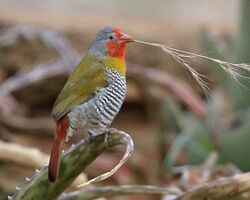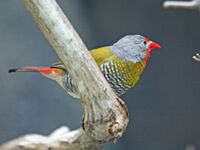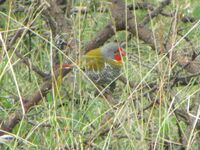Biology:Green-winged pytilia
| Green-winged pytilia | |
|---|---|

| |
| Adult male, Tsavo East NP, Kenya | |

| |
| Female, San Diego Zoo | |
| Scientific classification | |
| Domain: | Eukaryota |
| Kingdom: | Animalia |
| Phylum: | Chordata |
| Class: | Aves |
| Order: | Passeriformes |
| Family: | Estrildidae |
| Genus: | Pytilia |
| Species: | P. melba
|
| Binomial name | |
| Pytilia melba | |
| Synonyms | |
|
Fringilla melba Linnaeus, 1758 | |
The green-winged pytilia (Pytilia melba) is a small colourful seed-eating bird in the family Estrildidae. It is widespread throughout Sub-Saharan Africa, though it is more rarely seen in central, far southern and coastal western parts of the continent.
Taxonomy
The green-winged pytilia was formally described in 1758 by the Swedish naturalist Carl Linnaeus in the tenth edition of his Systema Naturae under the binomial name Fringilla melba.[2] No explanation was provided for the specific epithet melba but it could possibly be from a supposed Chinese word or place.[3] Linnaeus based his description on "The Green Gold-Finch" that had been described and illustrated in 1750 by the English naturalist George Edwards in his A Natural History of Uncommon Birds.[4] Edwards was uncertain of the origin of his specimen and Linnaeus mistakenly specified the locality as China. The specimen was subsequently assumed to be from Angola,[5] but this was restricted to Luanda in Angola by Phillip Clancey in 1962.[6] The green-winged pytilia is now placed in the genus Pytilia that was introduced in 1837 by the English naturalist William John Swainson for the red-winged pytilia.[7][8]
Eight subspecies are recognised:[8]
- P. m. citerior Strickland, 1853 – Mauritania, Senegal and Gambia to south Sudan
- P. m. jessei Shelley, 1903 – northeast Sudan to northwest Somalia
- P. m. soudanensis (Sharpe, 1890) – southeast Sudan, south Ethiopia, central, south Somalia, northeast Uganda and north, east Kenya
- P. m. percivali Van Someren, 1919 – central Kenya to north Tanzania
- P. m. belli Ogilvie-Grant, 1907 – east DR Congo and west Uganda to west Tanzania
- P. m. grotei Reichenow, 1919 – east Tanzania, north Mozambique and east Malawi
- P. m. hygrophila Irwin & Benson, 1967 – north Zambia and north Malawi
- P. m. melba (Linnaeus, 1758) – south Congo and Angola to southwest Tanzania and south to central Namibia, north South Africa and south Mozambique
Gallery
References
- ↑ BirdLife International (2017). "Pytilia melba". IUCN Red List of Threatened Species 2017: e.T22719344A111722703. doi:10.2305/IUCN.UK.2017-1.RLTS.T22719344A111722703.en. https://www.iucnredlist.org/species/22719344/111722703. Retrieved 11 November 2021.
- ↑ Linnaeus, Carl (1758) (in Latin). Systema Naturae per regna tria naturae, secundum classes, ordines, genera, species, cum characteribus, differentiis, synonymis, locis. 1 (10th ed.). Holmiae (Stockholm): Laurentii Salvii. p. 180. https://www.biodiversitylibrary.org/page/727087.
- ↑ Jobling, James A. (2010). The Helm Dictionary of Scientific Bird Names. London: Christopher Helm. p. 248. ISBN 978-1-4081-2501-4.
- ↑ Edwards, George (1751). A Natural History of Uncommon Birds. Part III. London: Printed for the author at the College of Physicians. p. 128, Plate 128. https://www.biodiversitylibrary.org/page/50196216.
- ↑ Zedlitz, O. Graf (1916). "Das Süd-Somaliland als zoogeographisches Gebiet" (in German). Journal für Ornithologie 64: 1–120 [31]. doi:10.1007/BF02250363. https://www.biodiversitylibrary.org/page/11696108.
- ↑ Clancey, Phillip Alexander (1962). "On the validity of Pytilia melba damarensis Neunzig, 1928". Bulletin of the British Ornithologists' Club 82: 3–5 [4]. https://www.biodiversitylibrary.org/page/40884093.
- ↑ Swainson, William John (1837). The Natural History of the Birds of Western Africa. 1. Edinburgh: W.H. Lizars. p. 203. https://archive.org/details/bub_gb_FAwAAAAAQAAJ/page/n270/mode/1up.
- ↑ 8.0 8.1 Gill, Frank; Donsker, David; Rasmussen, Pamela, eds (July 2021). "Waxbills, parrotfinches, munias, whydahs, Olive Warbler, accentors, pipits". IOC World Bird List Version 11.2. International Ornithologists' Union. https://www.worldbirdnames.org/bow/waxbills/. Retrieved 15 July 2021.
External links
- Species text in The Atlas of Southern African Birds
- Green-winged Pytilia (Melba Finch) Species Profile
Wikidata ☰ Q603124 entry
 |




